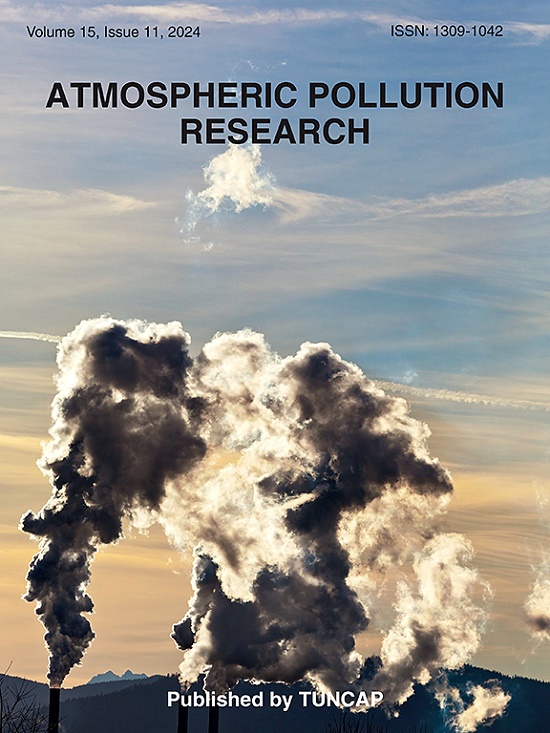季节性多站点低成本传感器测量估算肯尼亚内罗毕颗粒物污染的时空变异性
IF 3.5
3区 环境科学与生态学
Q2 ENVIRONMENTAL SCIENCES
引用次数: 0
摘要
由于当地和区域排放源的分布和强度,内罗毕等撒哈拉以南非洲城市的细颗粒物(PM2.5)环境浓度可能会有很大差异。我们利用低成本传感器和参考仪器数据,从城市背景(2020-2022年)站点和几个特定源站点(2021年6月至12月)评估内罗毕PM2.5的时空变异性。据我们所知,这项工作代表了这个城市最长和最具空间差异性的数据集。来自城市背景站点的数据表明季节变化是由降水驱动的。PM2.5浓度在暖干季节(JF, 17.1 ~ 18.8 μ m−3)和冷干季节(JJAS, 21.0 ~ 25.5 μ m−3)较高,在MAM (14.8 ~ 17.0 μ m−3)和OND (13.2 ~ 17.2 μ m−3)雨季较低。季节差异是系统性的,且大于年际变化。我们对污染源PM2.5测量值(2021年6月至12月)的分析显示,在污染较严重的JJAS季节,交通/住宅站点的PM2.5记录最高(28.8-29.1 μ m−3),其次是城市背景(23.3-24.1 μ m−3)和郊区背景(22.5 μ m−3)。受交通/居民影响的站点呈现出明显的早晚峰值,而城市背景和城郊背景站点的日剖面在白天保持平稳,但呈现出明显的傍晚峰值,再次表明了居民排放的影响。在城市背景地点和JJAS季节,额外的正午峰值可能与住宅烹饪排放有关。本文章由计算机程序翻译,如有差异,请以英文原文为准。

Seasonal multisite low-cost sensor measurements to estimate spatial and temporal variability of particulate matter pollution in Nairobi, Kenya
Ambient concentrations of fine particulate matter (PM2.5) in sub-Saharan African cities like Nairobi can vary significantly due to the distribution and intensity of local and regional emission sources. We assess the spatiotemporal variability of PM2.5 in Nairobi using low-cost sensor and reference instrument data from urban background (2020–2022) sites and from several source-specific sites (June to December 2021). To our knowledge, this work represents the longest and most spatially differentiated dataset for this city.
Data from urban background sites demonstrates seasonal variation driven by precipitation. PM2.5 concentrations were higher during the warm-dry (JF, 17.1–18.8 μg m−3) and cool-dry (JJAS, 21.0–25.5 μg m−3) seasons and lower during the rainy seasons of MAM (14.8–17.0 μg m−3) and OND (13.2–17.2 μg m−3). Seasonal differences are systematic, and larger than the inter-annual variability. Our analysis of source-specific PM2.5 measurements (June to December 2021) reveals for the more polluted JJAS season the highest PM2.5 recorded at traffic/residential sites (28.8–29.1 μg m−3), followed by urban background (23.3–24.1 μg m−3) and sub-urban background (22.5 μg m−3). The traffic/residential impacted sites demonstrate noticeable morning and evening peaks associated with traffic and residential emissions, while diurnal profiles for urban background and sub-urban background sites remain flat during the day but display noticeable evening peaks, pointing again to the impact of residential emissions. At the urban background site and during the JJAS season, an additional midday peak is probably related to residential cooking emissions.
求助全文
通过发布文献求助,成功后即可免费获取论文全文。
去求助
来源期刊

Atmospheric Pollution Research
ENVIRONMENTAL SCIENCES-
CiteScore
8.30
自引率
6.70%
发文量
256
审稿时长
36 days
期刊介绍:
Atmospheric Pollution Research (APR) is an international journal designed for the publication of articles on air pollution. Papers should present novel experimental results, theory and modeling of air pollution on local, regional, or global scales. Areas covered are research on inorganic, organic, and persistent organic air pollutants, air quality monitoring, air quality management, atmospheric dispersion and transport, air-surface (soil, water, and vegetation) exchange of pollutants, dry and wet deposition, indoor air quality, exposure assessment, health effects, satellite measurements, natural emissions, atmospheric chemistry, greenhouse gases, and effects on climate change.
 求助内容:
求助内容: 应助结果提醒方式:
应助结果提醒方式:


